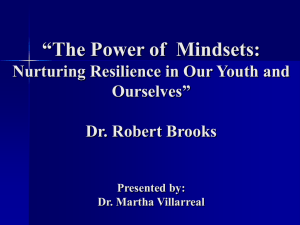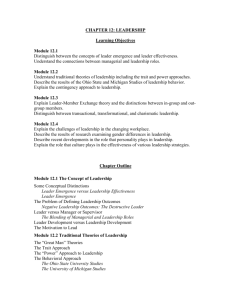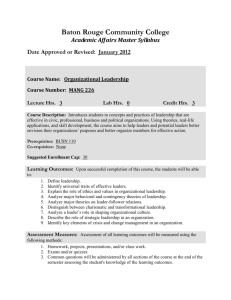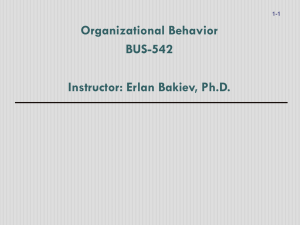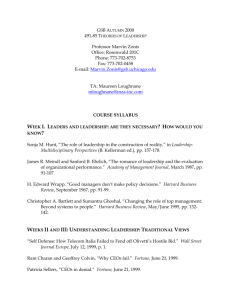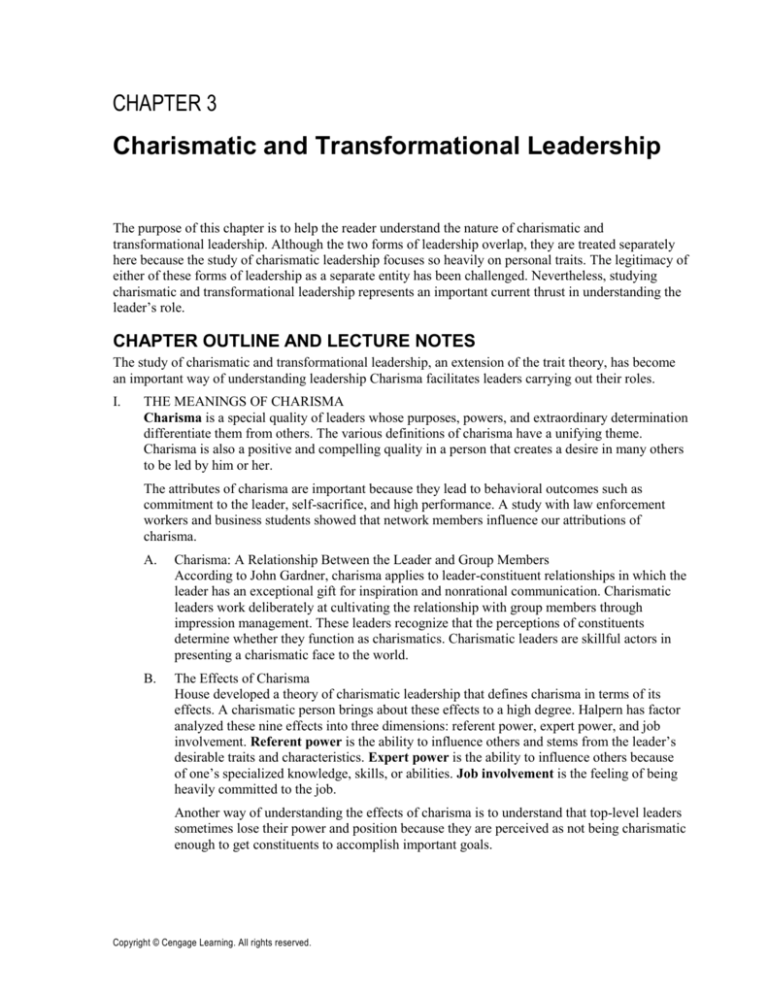
CHAPTER 3
Charismatic and Transformational Leadership
The purpose of this chapter is to help the reader understand the nature of charismatic and
transformational leadership. Although the two forms of leadership overlap, they are treated separately
here because the study of charismatic leadership focuses so heavily on personal traits. The legitimacy of
either of these forms of leadership as a separate entity has been challenged. Nevertheless, studying
charismatic and transformational leadership represents an important current thrust in understanding the
leader’s role.
CHAPTER OUTLINE AND LECTURE NOTES
The study of charismatic and transformational leadership, an extension of the trait theory, has become
an important way of understanding leadership Charisma facilitates leaders carrying out their roles.
I.
THE MEANINGS OF CHARISMA
Charisma is a special quality of leaders whose purposes, powers, and extraordinary determination
differentiate them from others. The various definitions of charisma have a unifying theme.
Charisma is also a positive and compelling quality in a person that creates a desire in many others
to be led by him or her.
The attributes of charisma are important because they lead to behavioral outcomes such as
commitment to the leader, self-sacrifice, and high performance. A study with law enforcement
workers and business students showed that network members influence our attributions of
charisma.
A.
Charisma: A Relationship Between the Leader and Group Members
According to John Gardner, charisma applies to leader-constituent relationships in which the
leader has an exceptional gift for inspiration and nonrational communication. Charismatic
leaders work deliberately at cultivating the relationship with group members through
impression management. These leaders recognize that the perceptions of constituents
determine whether they function as charismatics. Charismatic leaders are skillful actors in
presenting a charismatic face to the world.
B.
The Effects of Charisma
House developed a theory of charismatic leadership that defines charisma in terms of its
effects. A charismatic person brings about these effects to a high degree. Halpern has factor
analyzed these nine effects into three dimensions: referent power, expert power, and job
involvement. Referent power is the ability to influence others and stems from the leader’s
desirable traits and characteristics. Expert power is the ability to influence others because
of one’s specialized knowledge, skills, or abilities. Job involvement is the feeling of being
heavily committed to the job.
Another way of understanding the effects of charisma is to understand that top-level leaders
sometimes lose their power and position because they are perceived as not being charismatic
enough to get constituents to accomplish important goals.
Copyright © Cengage Learning. All rights reserved.
18
II.
Chapter 3: Charismatic and Transformational Leadership
TYPES OF CHARISMATIC LEADERS
Charismatic leaders have been categorized into five types: (1) socialized charismatic—uses
power to benefit others; (2) personalized charismatic—uses power to serve own interests; (3)
office-holder charismatic—much of the charisma stems from the glitter of the office the leader
holds; (4) personal charismatic—power stems from the faith people have in the leader; (5) divine
charismatic—leader is endowed with a gift of divine grace.
III. CHARACTERISTICS OF CHARISMATIC LEADERS
Charismatic leaders have unique characteristics, and many of these characteristics also apply to a
transformational leader—one who brings about positive, major changes in an organization. In
addition to the characteristics described in Chapter 2, charismatic leaders have other attributes: (1)
they are visionary; (2) they have masterful communication skills; (3) they have the ability to
inspire trust; (4) they are able to make group members feel capable; (5) they have energy and an
action orientation; (6) they have emotional expressiveness and warmth; (7) they romanticize risk;
(8) they use unconventional strategies; (9) they have a self-promoting personality; (10) they
challenge, prod, and poke; and (11) they are dramatic and unique. The last tactic is an amalgam of
many others.
IV. THE VISION COMPONENT OF CHARISMATIC LEADERSHIP
Vision is the ability to imagine different and better conditions and the ways to achieve them.
Recent neuroscience research suggests that visionaries have higher levels of brain activity in the
areas of the brain associated with visual processing and the organization of information.
Creating a vision is one of the major tasks of top management. Effective leaders have clear
visions, and vision is an important part of strategy implementation and bringing about change.
Charismatic leaders inspire others with their vision, because a vision uplifts and attracts others.
The charismatic leader also helps implement the vision. A good example of a vision is that of
Google: “To make nearly all information accessible to everyone all the time.”
To create a vision, it is helpful to obtain information from many sources, including (1) personal
intuition, (2) the work of futurists, (3) group discussions with group members, (4) other vision
statements, (5) the hopes and dreams of constituents, and (6) the larger organization’s vision.
Visions can be inspiring but they need to be supported by managers who are strong at
implementation.
V.
THE COMMUNICATION STYLE OF CHARISMATIC LEADERS
Charismatic and transformational leaders communicate their visions, goals, and directives in a
colorful, imaginative, and expressive manner. They also communicate openly and encourage
feedback.
A.
Management by Inspiration
An important factor in inspiring others is the ability to craft and articulate a highly emotional
message. Two such rhetorical techniques follow:
1.
B.
Using Metaphors and Analogies. A well-chosen analogy or metaphor appeals to the
intellect, imagination, and values.
2. Gearing Language to Different Audiences. Metaphors and analogies are inspiring, but
to be effective, leaders must also choose the level of language to suit the audience. An
executive’s ability to speak on a colloquial level helps create appeal.
Management by Storytelling
Management by storytelling is the technique of inspiring and instructing group members
by telling fascinating stories. The technique is a major contributor to building a strong
company culture. Storytelling as a leadership tool has been elevated to such a level that
Copyright © Cengage Learning. All rights reserved.
Chapter 3: Charismatic and Transformational Leadership
19
some companies hire corporate storytelling consultants to help their executives develop the
art.
VI. THE DEVELOPMENT OF CHARISMA
By developing some of the traits, characteristics, and behaviors of charismatic people, a person
can increase his or her charisma. Suggestions for developing charisma include the following: (1)
Create visions for others and connect the visions to their dreams; (2) be enthusiastic, optimistic,
and energetic; (3) be sensibly persistent; (4) remember names of people; (5) develop synchrony
with others (which helps make connections); (6) develop a personal brand including making an
impressive appearance; (7) be candid; and (8) display an in-your-face attitude.
VII. TRANSFORMATIONAL LEADERSHIP
The focus of transformational leadership is on what the leader accomplishes rather than on the
leader’s personal characteristics and relationships with group members. The transformational
leader helps bring about major, positive changes. In contrast, the transactional leader focuses on
more routine transactions, with an emphasis on rewarding group members for meeting standards.
A.
How Transformations Take Place
To accomplish his or her lofty purposes, the transformational leader attempts to overhaul the
organizational culture or subculture. Seven ways in which the leader brings about such
transformations are: (1) raising people’s awareness; (2) helping people look beyond selfinterest; (3) helping people search for self-fulfillment; (4) helping people understand the
need for change; (5) investing managers with a sense of urgency; (6) committing to
greatness; (7) adopting a long-range perspective and at the same time observing
organizational issues from a broad rather than a narrow perspective; (8) building trust, and
(9) concentrating resources on the areas most needing change.
B.
Attributes of Transformational Leaders
Eight qualities are particularly helpful in bringing about transformations: (1) charisma
including agreeableness and extroversion; (2) high emotional intelligence; (3) vision
creation; (4) encouraging the personal development of staff member; (5) supportive
leadership; (6) practicing empowerment; (7) innovative thinking; (8) lead by example; and
(9) moral reasoning,
C.
The Impact of Transformational and Charismatic Leadership on Performance and Behavior
Several empirical studies have been conducted on the effects of charismatic and
transformational leadership in work settings.
1.
2.
3.
Overall Validity of Transformational Leadership. A meta-analysis revealed that among
transformational leadership, transactional leader, and laissez-faire leadership showed
the highest overall relationship with six criteria including group or organization
performance. Transactional and transformational leadership were shown to be related.
Business Unit Performance. Howard and Avolio conducted a study with financial
managers about transformational leadership and business unit performance. Leaders
who displayed more individualized consideration, intellectual stimulation, and
charisma contributed positively to business unit performance. Leaders who used
management by exception and positive reinforcement were less likely to increase unit
performance.
Team Level Performance. A study with financial service teams in U.S. and Hong Kong
branches of a bank found that being perceived as transformational indirectly improved
team performance based on ratings. Transformational leadership enhanced group
potency which led to improved performance.
Copyright © Cengage Learning. All rights reserved.
20
Chapter 3: Charismatic and Transformational Leadership
VIII. CONCERNS ABOUT CHARISMATIC LEADERSHIP
The topic of charisma and transformational leadership has been challenged from two major
standpoints: the validity of the concept and the misdeeds of charismatic leaders.
A.
Challenges to the Validity of Charismatic Leadership
Most leadership researchers doubt that charisma can be accurately defined and measured.
Also, charismatic leaders are not liked by everyone. According to the concept of leadership
polarity, leaders are often either revered or vastly unpopular. People rarely feel neutral
about them. Also, charisma may not be required for leadership effectiveness. Bennis and
Nanus hypothesize that people who are outstanding leaders are perceived as charismatic by
their constituents as a result of their success.
B.
The Dark Side of Charismatic Leadership
Some people are concerned that charisma can be exercised for evil purposes. Some
charismatic leaders are unethical and lead their organizations toward illegal and immoral
ends. People are willing to follow the charismatic leader down a quasi-legal path because of
his or her referent power. Some charismatic leaders thus neglect their social responsibility,
the idea that organizations have an obligation to groups in society other than owners or
stockholders and beyond that prescribed by law or union contract.
Boards of directors currently seek CEOs who do not overemphasize charisma and celebrity
at the expense of running the business, thereby minimizing the dark side of charisma.
IX. GUIDELINES FOR ACTION AND SKILL DEVELOPMENT
To create charismatic appeal, make everyone you meet feel that he or she is quite important, use a
firm handshake and good eye contact, and give sincere compliments. Thank people frequently,
smile frequently, maintain a childlike fascination with your world, and be more animated than
others.
COMMENTS ON EXPERIENTIAL EXERCISES
Leadership Self-Assessment Quiz 3-1: The Emotional
Expressiveness Scale
Given that emotional expressiveness is such an important part of being perceived as charismatic, it is
worthwhile for students of leadership to reflect on their expressiveness.
Leadership Skill-Building Exercise 3-1: Formulating a Vision
Our experience is that students take readily to vision formulation. As one student said after completing
this exercise, “I do visions.” The visions that students construct in thirty minutes sound remarkably like
those it takes some organizations six months to formulate. If the completed visions are presented to the
rest of the class, feedback can be invited.
Leadership Skill-Building Exercise 3-2: Charismatic Leadership by
Storytelling
This exercise requires both analytical and imaginative thinking. An example that fits here is the
Domino Pizza emphasis on customer service. Supposedly, pizza dough was flown by airplane to a
Domino store to cover a shortage and maintain good service. The description of “moments of truth” in
The Leadership Challenge by Kouzes and Posner provides several relevant anecdotes.
Copyright © Cengage Learning. All rights reserved.
Chapter 3: Charismatic and Transformational Leadership
21
Leadership Self-Assessment Quiz 3-2: The Personal Magnetism
Deficit Inventory
Studying this deficit inventory might provide a few clues for personal development. The perceptive
student might see what could be done to turn around a few of these deficits, such as Number 10, “You
frequently make a statement or volunteer your opinion, and you barely receive a reaction.
Leadership Skill-Building Exercise 3-3: My Leadership Portfolio
Keeping track of a few charismatic behaviors can be helpful in developing charisma. Hints as to what
type of behavior is likely to be perceived as charismatic can be obtain from the chapter sections on
characteristics of charismatic leaders, developing charisma, and guidelines for action and skill
COMMENTS ON DISCUSSION QUESTIONS AND ACTIVITIES
1.
Identify a business, government, education, or sports leader whom you perceive to be charismatic.
Explain the basis for your judgment.
The particular leader singled out as charismatic is not as important as how the choice is justified,
such as pointing to the leader’s colorful communication style. Bill Gates and Steve Jobs often
come to students’ minds when they are asked to identify a charismatic business leader. The recent
successes of Apple have strengthened the perception of Jobs as charismatic.
2.
Athletes and other celebrities who smile frequently and wave to the audience are often described
as being “charismatic.” What is wrong or incomplete about this use of the term charisma.
Charisma in the context of the above statement refers essentially to a magnetic or likeable
personality. If the celebrities created visions for others, and were able to lead others successfully
they could be more accurately defined as charismatic.
3.
Describe how a person might write e-mail messages to give an impression of being charismatic.
To appear more charismatic, the person might follow the suggestions for persuasive
communication presented in Chapter 12. Any constructive way of appearing dramatic and unique,
such as colorful phrases, will help an e-mail message appear to have been sent by a charismatic
person. Emoticons, such as a “smiley,” are so widely used they might not contribute to a
charismatic image. Choosing an interesting font and background color or picture will sometimes
enhance charisma, but the written message is more important.
4.
Explain why the presence of a charismatic leader tends to enhance the job satisfaction of group
members.
A contributor to job satisfaction is the interpersonal relationship with the supervisor. When the
relationship is positive, job satisfaction is likely to increase. A charismatic leader typically has
good relationships with group members, and the group members enjoy the interaction they have
with the charismatic leader. As a result, that job satisfaction is likely to increase because a
component of satisfaction—the supervisory relationship—is positive. Furthermore, many
charismatic leaders are perceived as winners, and most people like to associate with winners.
5.
A concern has been expressed that leaders who are charismatic are often incompetent. They
simply get placed into key positions because they create such a good impression. What do you
think of this argument?
Many instances probably do exist of “counterfeit executives.” They are smooth and polished but
not very analytical. Our impression is that more of these “all form, no substance” managers are
weeded out in today’s thinned-out organizations.
Copyright © Cengage Learning. All rights reserved.
22
6.
Chapter 3: Charismatic and Transformational Leadership
Design a research study or survey to determine if you are perceived as being charismatic. Be
prepared to share your observations with other group members.
The survey might list all the characteristics of a charismatic leader. It then might ask respondents
who knew the person well to rate the person on a 1-to-5 scale. Write-in comments to this
anonymous survey about the person’s charismatic appeal might also be solicited.
7.
If a transformational leader is supposed to be so smart and visionary, why would he or she
emphasize empowerment in his or her leadership approach?
Because a transformational leader is smart and visionary he or she is likely to recognize the
contribution of empowerment. The transformational leader needs the contributions of many
people to bring about the transformations, and empowerment is a useful vehicle for enabling
workers to contribute. By empowering workers, the transformational leader will multiply his or
her personal talents.
8.
Provide an example of an athletic coach who proved to be a transformational leader, and justify
your opinion.
A reasonable answer here would point to an athletic coach who took over a losing, and perhaps
demoralized, team and converted that team into a winner in one or several seasons. Most sports
fans can point to a coach of this nature. Bill Parsells, the former NFL coach, turned around a
couple of teams. Rick Pitino, who has spent most of his time coaching men’s college basketball,
has turned around several losing programs. Greg Schiano, the head coach of football at Rutgers
University, turned around their program over several years.
9.
When Robert Nardelli was appointed CEO and Chairman of Chrysler in 2007, some of his first
steps were to shutter a number of factories and lay off about 20,000 workers in order to reduce
costs. How might these actions impact his status as a transformational leader?
Laying off large number of workers to attain a transformation has become almost standard
practice for business leaders, so Nardelli’s status as a transformational leader is likely to be
enhanced rather than tarnished. However, a great transformational leader would work with staff
members to turn around a company without doing so much damage to workers and suppliers.
What would happen, for example, if Nardelli could have inspired every Chrysler employee to
induce one family member, relative, or friend to purchase a Chrysler or Jeep vehicle? The
financial results would have helped the company dramatically.
10. What opportunities might a first-level supervisor or team leader have to be a transformational
leader?
A first-level supervisor or team leader will sometimes have the opportunity to improve greatly the
performance of an underperforming and/or demoralized organizational unit. A supervisor or team
leader is often assigned to such a unit as a developmental experience.
PLAUSIBLE RESPONSES TO CASE QUESTIONS
Leadership Case Problem A: The Image Doctor is In
This case provides some insights into the steps some people will take to develop a more positive, and
perhaps more charismatic, image.
1.
In which aspects of charisma is Arruda providing coaching and training?
Arruda is providing coaching and training in the impression management aspects of charisma,
such as how others perceive you based on you Web presence and personality traits.
Copyright © Cengage Learning. All rights reserved.
Chapter 3: Charismatic and Transformational Leadership
2.
23
To what extent is Aruda professionally qualified to correct the personalities of his clients?
Many people would argue that Aruda is not professionally qualified to correct the personalities of
his clients because he is not a mental health professional, similar to the arguments against
executive coaches. However, what Aruda refers to as a personality correction appears to mean
modifying a trait rather than truly changing a personality. Another argument is favor of Aruda, is
that coaching is not the equivalent of mental health counseling.
3.
What is your reaction to Arruda’s statement, “If you don’t show up on Google, you don’t exist”?
In reality, not every person who is making a contribution to society has a Google presence. A
person is most likely to have a search engine entry is he or she has been cited in a newspaper, has
a blog or Website, or has been active in the community. My opinion is that the statement about
not existing is you do not show up on Google is a false exaggeration. Showing up on a search
engine is more important for scholars, consultants, celebrities, and business owners than it is for
corporate managers and professionals.
4.
Explain whether you would invest your own money in having the CareerCoach Institute help you
develop a personal brand.
The answer here is a function of how much importance the student places in impression
management and having a personal brand. Although a fee of up to $15,000 may appear shocking,
many people spend that much money on an exotic vacation. Having a personal brand could pay
more personal rewards in the long run than one exotic vacation.
5.
Out of curiosity, if you were a car, what make and model would you be? What about the instructor
of this course?
Some people believe that the car a person identifies with tells a lot about his or her personality.
Car ownership might be a different story, because relatively few people are in a financial position
to purchase their idea vehicle. An enjoyable class discussion might be to explore why a particular
vehicle was chosen, such as why the instructor would be a Cadillac Escalade, Lexus, or Ferrari (or
Ford Taurus).
Leadership Case Problem B: Time to Rebound at Willow Pond
1.
Why is this case included in a chapter about charismatic and transformational leadership?
This case deals with charismatic and transformational leadership because Heather will have to
turn around a troubled organization. Turnarounds can be applied to organizations of all sizes.
2.
What aspects of transformational leadership should Heather emphasize in her approach to
rehabilitating Willow Pond?
Heather should most likely begin with an analysis of what changes need to be made, as she has
already done. Next, she should work with staff members to sell them on the importance of change.
Adopting a long-range perspective about survival would be helpful, as would be building trust. In
recognition of the fact that Willow Pond would have limited funds for bringing about change,
Heather should focus resources where change is needed the most, such as improved guest care.
3.
How might emphasizing the charismatic aspects of her personality help Heather bring about the
necessary changes?
Willow Pond is probably not in a position to offer substantial financial bonuses to workers who
help bring about the changes necessary for the assisted-living home to survive. She may therefore
need to rely more on inspiring workers with the charismatic aspects of her personality. Heather
can at least prompt workers at the home to understand how positive changes in the home will
enhance their working conditions.
Copyright © Cengage Learning. All rights reserved.
24
4.
Chapter 3: Charismatic and Transformational Leadership
Why might the job at Willow Brook prove to be a wonderful career opportunity for Heather
Osaka?
As will be described in Chapter 15, one of the best ways to develop as a leader is to conquer a
difficult situation. In this case Willow Pond is almost on the verge of failure, so Heather will have
an excellent opportunity to develop her transformational leadership skills. She will probably have
to overcome the resistance to change of workers at the home who like conditions as they exist
today.
Copyright © Cengage Learning. All rights reserved.

